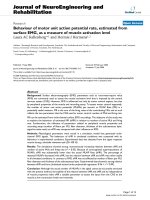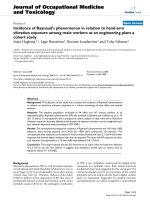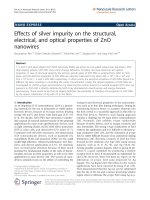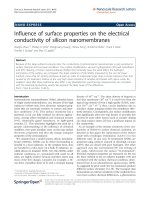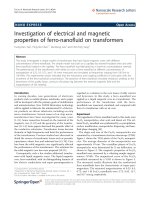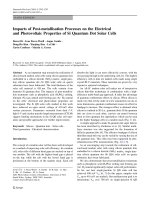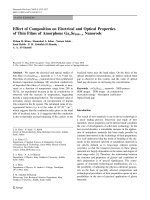Báo cáo hóa học: " Department of Electrical Engineering, Columbia " pot
Bạn đang xem bản rút gọn của tài liệu. Xem và tải ngay bản đầy đủ của tài liệu tại đây (667.74 KB, 2 trang )
EURASIP Journal on Applied Signal Processing 2004:1, 3–4
c
2004 Hindawi Publishing Corporation
Editorial
Xiaodong Wang
Department of Electrical Engineering, Columbia University, New York, NY 10027, USA
Email:
Edward R. Dougherty
Department of Electrical Engineering, Texas A&M University, 3128 TAMU College Station, TX 77843-3128, USA
Email:
Yidong Chen
National Human Genome Research Institute, National Institutes of Health, Bethesda, MD 20892, USA
Email: yidong@nhgr i .nih.gov
Carsten O. Peterson
Department of Theoretical Physics , Lund University, S
¨
olvegatan 14A, SE-22362 Lund, Sweden
Email:
The advent of new methods to obtain large-scale surveys of
gene expression in which transcript levels can be determined
for thousands of genes simultaneously has facilitated the ex-
pansion of biological understanding from the analysis of in-
dividual genes to the analysis of systems of genes (and pro-
teins). This change characterizes the movement into the era
of functional genomics. Central to this movement is an ap-
preciation of the gene’s role in cellular activity as it functions
in the context of larger molecular networks.
Two salient goals of functional genomics are to screen for
key genes and gene combinations that explain specific cel-
lular phenotypes (e.g. disease) on a mechanistic level, and
to use genomic signals to classify disease on a molecular
level. Signals generated by the genome must be processed to
characterize their regulatory effects and their relationship to
changes at both the genotypic and phenotypic levels. Since
transcr iptional (and posttranscriptional) control involves the
processing of numerous and different kinds of signals, math-
ematical and computational methods are required to model
the multivariate influences on decision-making in complex
genetic networks.
Historically, it has been within the domain of signal
processing where such methodologies have been extensively
studied and developed—in particular, estimation, classifi-
cation, pattern recognition, automatic control, information
theory, networks, computation, imaging, and coding. More-
over, signal processing is based on a holistic view of regu-
lation and communication. As a discipline, signal process-
ing involves the construction of model systems composed of
various mathematical structures, such as systems of differen-
tial equations, graphical networks, stochastic functional re-
lations, and simulation models. Therefore it is not surpris-
ing that the advent of high-throughput genomic and pro-
teomic technologies is drawing a growing interest from the
signal processing community in relation to attacking the fun-
damental issues of expression-based functional genomics.
The twin aims of tissue classification and pathway mod-
eling require a broad range of signal processing approaches,
including signal representation relevant to transcription and
system modeling using nonlinear dynamical systems. To cap-
ture the complex network of nonlinear information process-
ing based upon multivariate inputs from inside and outside
the genome, regulatory models require the kind of nonlinear
dynamics studied in signal processing and control. Genomics
requires its own model systems, not simply straightforward
adaptations of currently formulated models. New systems
must capture the specific biological mechanisms of opera-
tion and distributed regulation at work within the genome.
It is necessary to develop nonlinear dynamical models that
adequately represent genomic regulation for diagnosis and
therapy.
Genomic signal processing (GSP) is the discipline that
studies the processing of genomic signals. The aim of GSP
is to integrate the theory and methods of signal process-
ing with the global understanding of functional genomics,
with special emphasis on genomic regulation. Hence, GSP
encompasses various methodologies concerning expression
profiles: detection, prediction, classification, control, and
4 EURASIP Journal on Applied Signal Processing
dynamical modelling of gene networks. Moreover, since RNA
coding is controlled by DNA sequencing, the analysis of DNA
sequences, treated as signals in their own right, can be con-
sidered within the domain of GSP. Overall, GSP is a fun-
damental discipline that br ings to genomics the structural
model-based analysis and synthesis that form the basis of
mathematically rigorous engineering.
This special issue of EURASIP JASP contains some ex-
amples of GSP applications. The issue starts with three pa-
pers (Song et al., Chakravarthy et al., and Sussillo et al.) on
spectral analysis of DNA sequences. The next paper by Hero
et al. treats statistical signal-processing-based gene selection.
The following two papers (Wu et al. and Giurc
˘
aneanu et
al.) develop signal processing techniques for gene clustering.
The next two papers treat DNA sequence segmentation using
statistical signal processing (Nicorici and Astola) and image
processing (Hua et al.), respectively. Signal processing meth-
ods for gene prediction and regulatory network inference are
developed in the papers by Fox and Carreira, Zhou et al.,
andIvanovetal.,respectively.ThepaperbyCristeadeals
with revealing large-scale chromosome features by analysis
of genomic signals. In addition, the paper by Lennartsson
and Nordin treats peptides identification using genetic pro-
gramming. Finally, an invited tutorial by Dougherty et al.
discusses key issues in GSP.
The guest editors would like to thank all the authors for
contributing their work to this special issue. We would also
like to express our deep gratitude to all reviewers for their
diligent efforts in evaluating all submitted manuscripts.
Xiaodong Wang
Edward R. Dougherty
Yidong Chen
Carsten O. Peterson
Xiaodong Wang received the B.S. degree
in electrical engineering and applied math-
ematics (with the highest honor) from
Shanghai Jiao Tong University, Shanghai,
China, in 1992; the M.S. degree in electri-
cal and computer engineering from Purdue
University in 1995; and the Ph.D. degree in
electrical engineering from Princeton Uni-
versity in 1998. From July 1998 to Decem-
ber 2001, he was an Assistant Professor in
the Department of Electrical Engineering, Texas A&M University.
In January 2002, he joined the Department of Electrical Engineer-
ing, Columbia University, as an Assistant Professor. Dr. Wang’s re-
search interests fall in the general areas of computing, signal pro-
cessing, and communications. He has worked in the areas of dig-
ital communications, digital signal processing, parallel and dis-
tributed computing, nanoelectronics, and bioinformatics, and has
published extensively in these areas. His current research inter-
ests include wireless communications, Monte Carlo based statis-
tical signal processing, and genomic signal processing. Dr. Wang
received the 1999 NSF CAREER Award and the 2001 IEEE Com-
munications Society and Information Theory Society Joint Paper
Award. He currently serves as an Associate Editor for the IEEE
Transactions on Communications, the IEEE Transactions on Wire-
less Communications, the IEEE Transactions on Signal Processing,
and t he IEEE Transactions on Information Theory.
Edward R. Dougherty is a Professor in
the Department of Electrical Engineering at
Texas A&M University in College Station.
He holds an M.S. degree in computer sci-
ence from Stevens Institute of Technology
in 1986 and a Ph.D. degree in mathemat-
ics from Rutgers University in 1974. He is
the author of eleven books and the editor
of other four books. He has published more
than one hundred journal papers, is an SPIE
Fellow, and has served as an Editor of the Journal of Electronic
Imaging for six years. He is currently Chair of the SIAM Activity
Group on Imaging Science. Prof. Dougherty has contributed ex-
tensively to the statistical design of nonlinear operators for image
processing and the consequent application of pattern recognition
theory to nonlinear image processing. His current research focuses
on genomic signal processing, with the central goal being to model
genomic regulatory mechanisms. He is Head of the Genomic Signal
Processing Laboratory at Texas A&M University.
Yidong Chen receivedhisB.S.andM.S.de-
grees in electrical engineering from Fudan
University, Shanghai, China, in 1983 and
1986, respectively, and his Ph.D. degree in
imaging science from Rochester Institute of
Technology, Rochester, NY, in 1995. From
1986 to 1988, he joined the Department
of Electronic Engineering of Fudan Univer-
sity as an Assistant Professor. From 1988 to
1989, he was a Visiting Scholar in the De-
partment of Computer Engineering, Rochester Institute of Tech-
nology. From 1995 to 1996, he joined Hewlett Packard Company
as a Research Engineer, specialized in digital halftoning and color
image processing. Currently, he is a Staff Scientist in the Cancer
Genetics Branch of National Human Genome Research Institute,
National Institutes of Health, Bethesda, Md, specialized in cDNA
microarray bioinformatics and gene expression data analysis. His
research interests include statistical data visualization, analysis and
management, microarray bioinformatics, genomic signal process-
ing, genetic network modeling, and biomedical image processing.
Carsten O. Peterson is a Professor at the
Department of Theoretical Physics and
Head of the Complex Systems Division at
Lund University, Sweden. His current re-
search area is computational biology with
the focus on microarray analysis, genetic
networks, systems biology, and alignment
algorithms. Dr. Peterson’s research interests
were initially in theoretical particle physics,
multiparticle production, quantum chro-
modynamics, and also statistical mechanics. His research areas have
subsequently evolved into spin systems, data mining, and time se-
ries analysis with some emphasis on biomedical applications, re-
source allocation problems, Monte Carlo sampling methods and
mean field approximations, thermodynamics of macromolecules,
protein folding/design, and computational biology in general. Dr.
Peterson joined the Department of Theoretical Physics at Lund
University in 1982, had an industrial intermission with Microelec-
tronics and Computer Corporation (Austin, Tex) during 1986–
1988, and held postdoctoral positions at Stanford (1980–1982) and
Copenhagen (1978–1979). Dr. Peterson received his Ph.D. degree
in theoretical physics and M.S. degree in physics from Lund Uni-
versity in 1977 and 1972, respectively.
